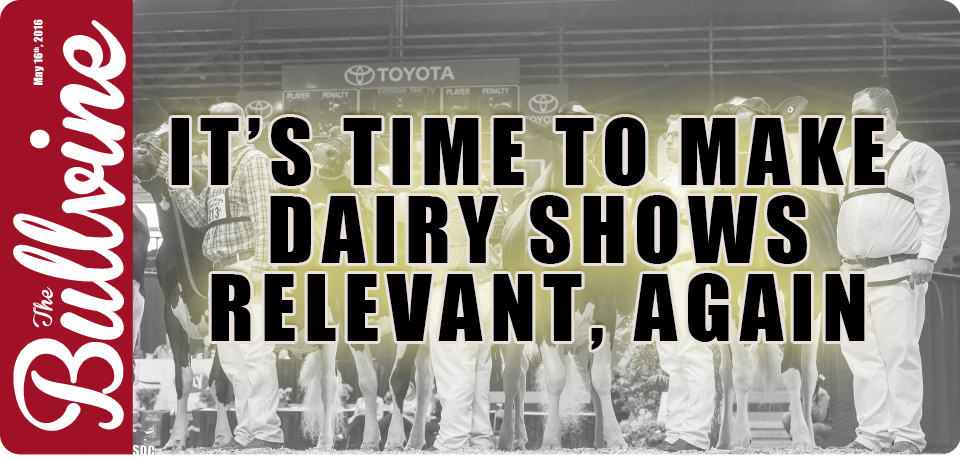Show supporters can quote many reasons for why the time, effort and resources that they put towards exhibiting cattle are positive. At the same time, there are detractors who question why breeds and sponsors should support cattle shows. The detractors see no benefit to dairy cattle improvement from the show circuit.
What is Relevant Today?
What is seen as relevant differs over the entire spectrum of dairy cattle breeders? Something that is relevant to one group is not as important to another. The show competition is not about focusing on a win or lose for one of these groups over their differently focused peers. It’s about having a showcase not only for breeders but the consuming public. To stay relevant dairy breeders and breed associations must take the opportunity to be the kind of leaders and visionaries that advance the dairy industry. Being relevant requires that new ideas are continually being brought on board as times and circumstances change. The Bullvine offers some thoughts for dairy show organizers to consider in raising the bar for the future of the industry.
Minimum Production Required
Since type is the deciding factor in the show ring. Ways to include production in shows has been tried in numerous ways. Over fifty years ago, The Honorable Harry Hays, Canadian Minister of Agriculture, initiated a federally financial supported program that required that cows or dams of heifers meet minimum production requirements. The program lasted for many years until a subsequent government looked for areas to reduce the federal government agriculture budget and eliminated the support. While it lasted, the program assisted with more official milk recording and breed improvement.
Just two years ago Holstein USA raised the minimum production from 125,000 lbs to 150,000 lbs for cows to be eligible for entry into Production Cow Classes at Holstein designated shows. This move reflects the increasing levels of production.
It was fascinating at the 2016 Swiss Expo to see a twenty-year-old that had produced 200,000 kgs. Back when she was a heifer she had been a class winner at the very first Swiss Expo. Now that is not a class that shows might consider, but it was interesting to see this grand matriarch paraded.
Best by Age
For perhaps two decades now, show have had an Intermediate Champion or Best Junior Cow. This category has been very well received. Could the champion categories be extended to have a Champion Calf and Champion Yearling?
Recently, at two high-quality North American Spring Shows, Junior Two Year Olds have been named Grand Champion Female. That has not been without controversy.
Often judges state that they give preference to mature females. The words often used are that ‘she has stood the test of time”. And, by comparison, the more junior cows which have not calved as often will have their day in the bright lights when they mature.
So what is the purpose of naming the Grand Champion Female? Is it to reward age or to identify the best in the show without bias related to maturity. In fact, it may even be a question of using maturity for placings of first and second lactation cows. It is our observation that lack of body depth in first and second lactation is not all that bad. Young cows should look like young cows.
Best by Index
The organizers of the recent Canadian National Convention Holstein show took the bull by the horns, so to speak, and introduced a class for genomically indexed heifers. The show was organized by members of Holstein Canada from Western Canada. The concept for the class was put forward more than two years ago by Dr. David Chalack of RockyMountain Holsteins. An interesting side note is that Harry Hays and David Chalack, two show class innovators, both originate from Calgary Alberta. The Hays and Chalack Families have been long time supporters of Canadian Holstein improvement and foreign cattle marketing. David puts it this way “Shows must be relevant to not only today but also in the future. Genomic indexes are twice as accurate as the old Parent Average Indexes. Our shows need to be leading by example in bringing out the quality of animals that will meet the future needs of all breeders”. He continues “ The show organizers considered making the requirements higher for individual parts of the LPI but in the end decided to set the LPI at a reasonable level. I was thrilled to see the interest in the class. Western Canada Holstein breeders throw the torch to shows, anywhere on the globe, to take the show ring to new heights.”
The class was truly a success. The top two placing heifers, with at least 2600 LPI, from the first five heifer classes paraded before the show judge. The Champion Index heifer was Barclay Doorman Cobra exhibited by Hamming Holsteins from British Columbia, and reserve was also exhibited by Hamming Holsteins. Winning both Champion and Reserve Index Heifer indeed gives this owner a great marketing opportunity.
The Bullvine Bottom Line
With much talk about shows becoming less and less relevant in dairy cattle improvement, it rests on the shoulders of breeds and show organizers to put in place new classes that extend the reach from type only to include all aspects of dairy cattle breeding which includes production, durability and health and fertility. The time has come for highlighting modern dairy relevance in the show ring.

Get original “Bullvine” content sent straight to your email inbox for free.















Leave a Reply
You must be logged in to post a comment.